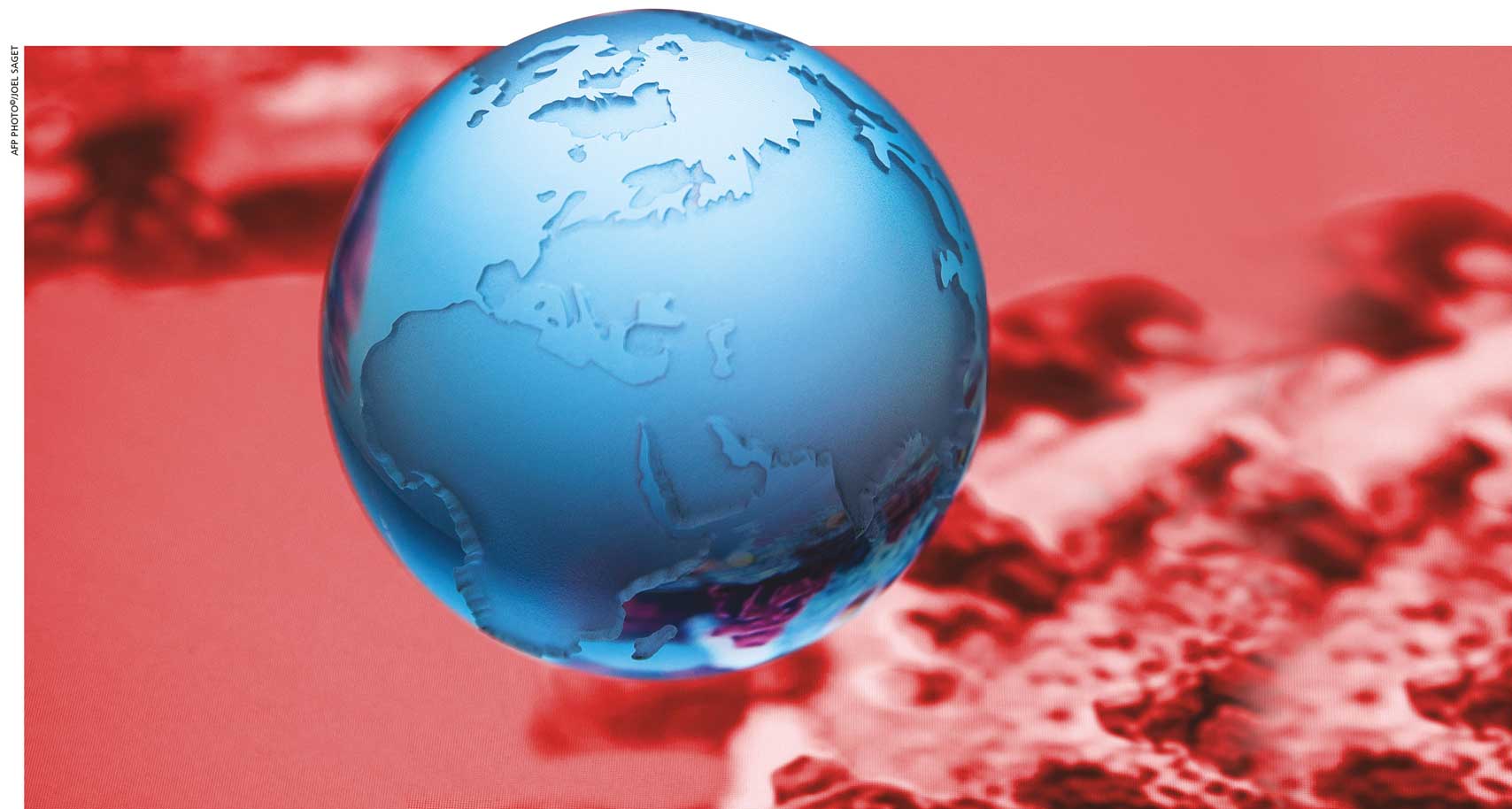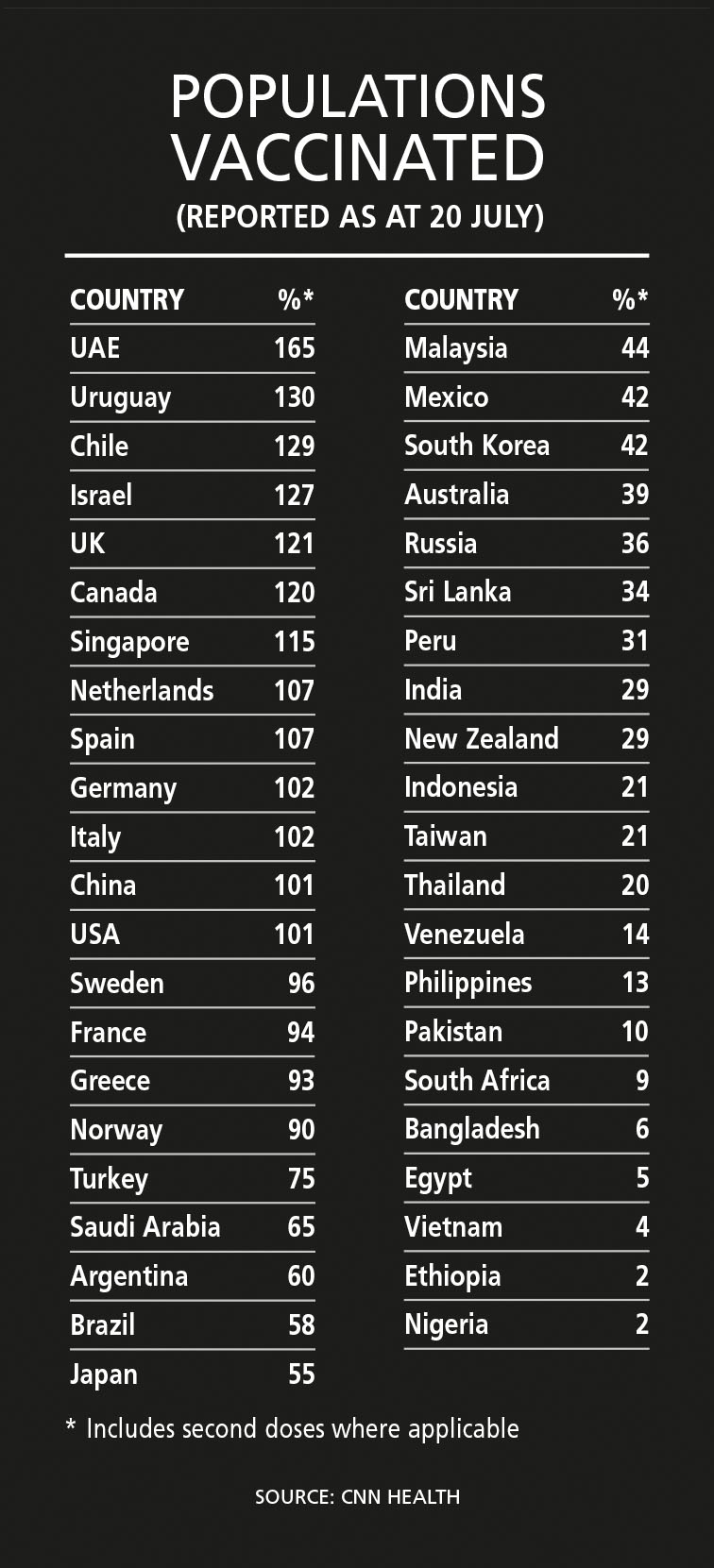STATE OF THE WORLD
COVID-19 CONTINUES TO WREAK HAVOC
Saro Thiruppathy reviews the status of the global pandemic and long-term decisions that Singapore is taking to cope with it
It’s been some 17 months since the WHO declared a pandemic due to the spread of the SARS-CoV-2 virus, which it named ‘COVID-19.’ After China formally announced the presence of a mystery illness at the end of December 2019, the UN health body waited until 11 March 2020 to make sure it had spread sufficiently across the world before making its devastating declaration.
 The total global COVID-19 caseload on 20 July stood at around 192 million and the death toll amounted to slightly over four million. Meanwhile, more than three billion vaccine doses had been administered across the globe at that date.
The total global COVID-19 caseload on 20 July stood at around 192 million and the death toll amounted to slightly over four million. Meanwhile, more than three billion vaccine doses had been administered across the globe at that date.
And the US continued to dominate with the highest number of cases (35 million) and deaths (nearly 625,000). India came in second with 31.1 million cases and Brazil recorded more than 19 million infections at the time.
Countries which have recorded more than three million cases include Russia, France, Turkey, the UK, Argentina, Colombia, Italy, Spain, Germany and Iran.
COVID-19 deaths show Brazil in second place with 543,000 fatalities and India following with in excess of 415,000. Other countries with very high death tolls include Mexico, Peru, Russia, the UK, Italy, France and Colombia.
VARIANTS OF CONCERN
There are currently two types of variants – those of concern to the World Health Organization and others, which are only of interest.
The variants of concern (VOC) are Alpha and Delta, which were first identified in the UK and India respectively. Delta wreaked havoc in India before moving on to infect the rest of the world.
 Meanwhile, the Delta variant is mostly affecting those who have not been vaccinated, and countries such as the US, the UK and Israel are experiencing an uptick in COVID-19 cases among youth who are largely unvaccinated.
Meanwhile, the Delta variant is mostly affecting those who have not been vaccinated, and countries such as the US, the UK and Israel are experiencing an uptick in COVID-19 cases among youth who are largely unvaccinated.
Even as the UK dispensed with health protocols such as physical distancing rules, the mask mandate and quarantine requirements, there is a pushback against Europe’s planned reopening for summer due to a surge in cases in Spain and Portugal.
India is seeing a drop in cases in many states but a couple such as Maharashtra and Kerala are reporting an increase in infections. Australia, South Africa and Asian countries recently reintroduced preventive measures such as mandatory mask wearing and lockdowns, to try and curb the spread of Delta outbreaks.
Even though the US has vaccinated 68 percent of its adult population, President Joe Biden is sending federal employees on a door-to-door campaign to urge all Americans to get vaccinated. This is a desperate bid to keep the Delta variant from causing further damage since it has already spread rapidly in several states and districts that are mostly populated by ‘anti-vaxxers.’
In spite of the high vaccination rate, American health authorities are warning that indoor masks and other public health protection measures may see a comeback as the country enters autumn.
While much of the world is worrying about Delta, another two variants are moving stealthily around the world – viz. the Gamma and Lambda variants. The WHO had labelled Lambda only as a ‘variant of interest’ rather than a VOC in June even though it has been spreading rapidly in South America since August 2020, and has infected 29 countries including the US, Canada, Germany, Spain, Israel,
France, the UK and Zimbabwe among others.
When asked what needs to happen for the WHO to declare that Lambda is a VOC, its COVID-19 Technical Lead Maria Van Kerkhove noted: “It would become a variant of concern if it has demonstrated pathways of increased transmissibility – if it has increased severity, for example; or has some kind of impact on our countermeasures.”
THE WAY FORWARD While some countries like the UK have opened up with no proper plan seemingly in sight, Singapore is doing so in a strategic and sensible manner.
Its government is drawing up a road map that will centre on a strategy to live with the virus. It believes that COVID-19 is unlikely to fade away in the near future; so instead of focussing on herd immunity, Singapore will treat the disease as being endemic.
Health protocols such as the mask mandate and check-ins at public places with a tracing app will remain but the government is considering exit strategies in line with its impressive rate of vaccination. On 20 July, Singapore had administered in excess of 6.7 million doses of vaccines and 47 percent of its people were inoculated with both doses. It’s expected that two-thirds of the population would be fully vaccinated by the end of August.
The road map for ‘living normally’ will most probably involve allowing an infected person to recover at home and enabling people to check their own health, using fast and easy test kits domestically. Singaporeans will also be able to travel to less risky countries with mutually recognised vaccine certificates.
COVID-19 test kits are available at pharmacies and an NGO has begun distributing a fingertip oximeter free to every Singaporean household to check the blood oxygen levels of people. A low oxygen level generally indicates the presence of COVID-19.
Since neighbouring Indonesia, Thailand and Malaysia are experiencing spikes in infections, it doesn’t bode well for the island-nation’s main transport and tourism sectors. Nevertheless, the government’s cautious paradigm shift is a reason for hope in Asia as Singaporeans learn to live with the virus.
While some countries like the UK have opened up with no proper plan seemingly in sight, Singapore is doing so in a strategic and sensible manner




